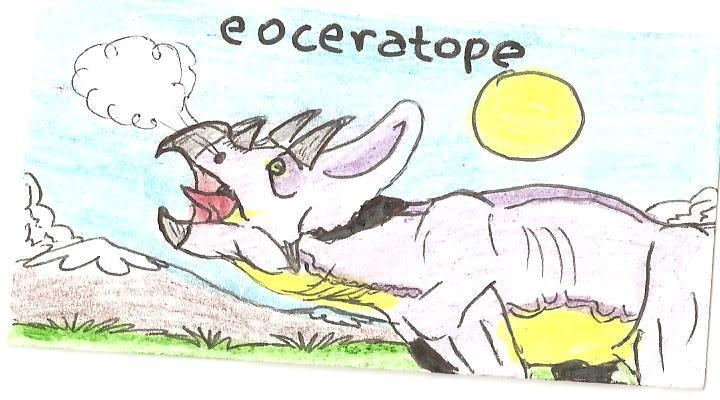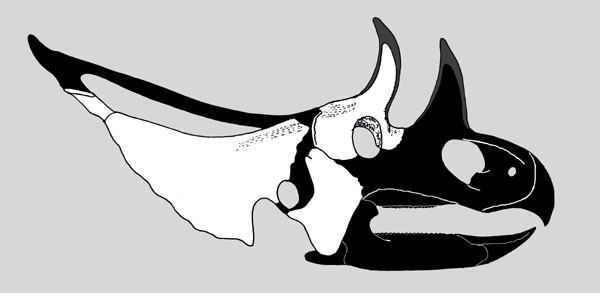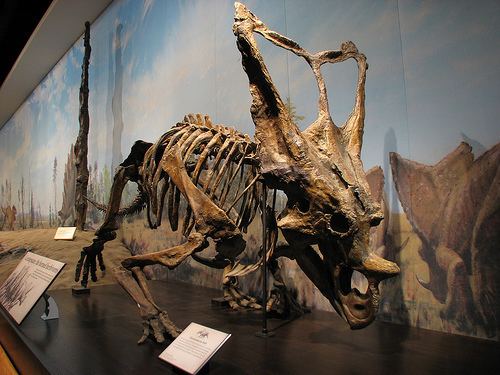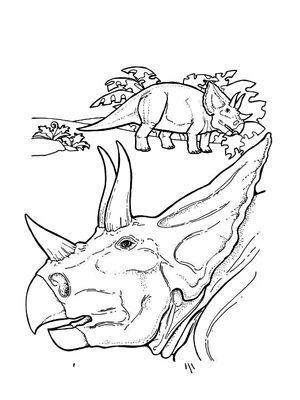Kingdom Animalia Clade Dinosauria Subfamily †Chasmosaurinae Rank Genus | Class Reptilia Family †Ceratopsidae Phylum Chordata Order Ornithischia | |
 | ||
Similar Gravitholus, Asiaceratops, Cryptosaurus, Echinodon, Dryptosauroides | ||
Eoceratops is a genus of ceratopsian dinosaurs containing the single species Eoceratops canadensis. It is a chasmosaurine ceratopsian which lived during the Late Cretaceous period, in what is now Western Canada.

In 1901, Lawrence Morris Lambe at the Berry Creek in Alberta discovered a dinosaur skull. In 1902, he named it as a new species of the genus Monoclonius: Monoclonius canadensis. The specific name referred to the provenance from Canada.
The holotype, NMC 1254, was found in an layer of the Belly River Group dating from the middle Campanian. It consists of a partial skull, lower jaw and front back vertebra, of a juvenile animal. The head elements include a right eye socket with brow horn, the right squamosal and parietal corner of the neck frill and the rear left lower jaw. Lambe thought he had also discovered a right jugal but this was later identified as the right nasal bone. In addition Lambe referred a right lower jaw, specimen NMC 284 found in 1897, and another brow horn, specimen NMC 190.

In 1905, in a publication by Timothy William Stanton and John Bell Hatcher, the species was assigned to the genus Ceratops, as a Ceratops canadensis. This was confirmed in Hatcher's posthumous publication of 1907. On this occasion, Hatcher additionally referred a maxilla and a tooth and suggested an identity with Monoclonius, later Chasmosaurus, belli.

In 1915, Lambe made it a separate genus, Eoceratops. The generic name adds a Greek ἠώς, eos, "dawn", to Ceratops, in view of the greater age. The combinatio nova is Eoceratops canadensis. The type species is Monoclonius canadensis.

After 1915, several specimens have been referred to Eoceratops. One of these was a fossil in 1913 discovered by William Edmund Cutler and unearthed by him in 1920. After Cutler's untimely death, American paleontologists presumed it had been stored in Calgary Zoo and had eventually been destroyed. However, in 2010 it transpired that Cutler had sold it to the British Museum of Natural History and that it was still in its collection as Chasmosaurus specimen BMNH R4948. Another specimen is UALVP 40, a skull excavated by George Fryer Sternberg in 1921, and in 1923 referred to Eoceratops by Charles Whitney Gilmore. In 1933, Richard Swann Lull considered it a possible female of Chasmosaurus kaiseni. In 1990, Thomas Lehman combined the Chamosaurus kaiseni material with Eoceratops into a new species of Chasmosaurus: Chasmosaurus canadensis.

In 2010, Nicholas R. Longrich named and described skull TMP 1983.25.1, by Lehman referred to C. canadensis, as a new genus and species, Mojoceratops perifania. Longrich concluded that the holotype of Eoceratops, as that of C. kaiseni, probably belongs to Mojoceratops. This would make Eoceratops a possible senior synonym of Mojoceratops. However, Longrich also considered the Eoceratops type specimen as too poorly preserved for a reliable determination, especially as it belonged to a juvenile individual. He stated that Eoceratops is a nomen dubium. Longrich also considered the C. kaiseni type specimen nondiagnostic and stated it too is a nomen dubium.
Campbell and colleagues, in their 2016 analysis of Chasmosaurus specimens found Eoceratops and C. kaiseni to be referable to Chasmosaurus sp. due to the lack of the parietal preserved in the holotypes of both. They also agreed with Maidment & Barrett 2011 that Mojoceratops is a synonym of Chasmosaurus russelli.
The holotype represents a rather small individual. The squamosal has, measured along the outer curve, a length of fifty-seven centimetres and a width of thirty-eight centimetres. There are six episquamosalia. The juvenile status is confirmed by the short and wide squamosal, a short snout and the epinasal not being fused. At the base of the nasal horn, in a crescent-shaped depression, the contact facet with the nasal bone is visible, seeming to imply the horn is a separate ossification that Lambe in 1915 coined the "epinasal". The brow horns of Eoceratops are markedly longer than those of Chasmosaurus and with a length of 216 millimetres attaining twice their base length. The brow horns are curved to the rear. Lambe assumed that this curvature would not change during growth and thus was a valid distinguishing trait of the taxon. Today however, it is understood that the horn curvature in chasmosaurines typically reorients itself to the front when an adult age is reached. The squamosal side of the neck shield is strongly hooked in front, a basal trait.
In 1902, Lambe placed Monoclonius canadensis in the Ceratopsidae. In 1915, Lambe created a separate Eoceratopsinae, to which group also Anchiceratops, Triceratops and Diceratops were thought to belong, in distinction to a Chasmosaurinae. The eoceratopins were assumed to distinguish themselves by more compact and resistant neck shields. Today all these forms, including Eoceratops itself, are considered Chasmosaurinae.
